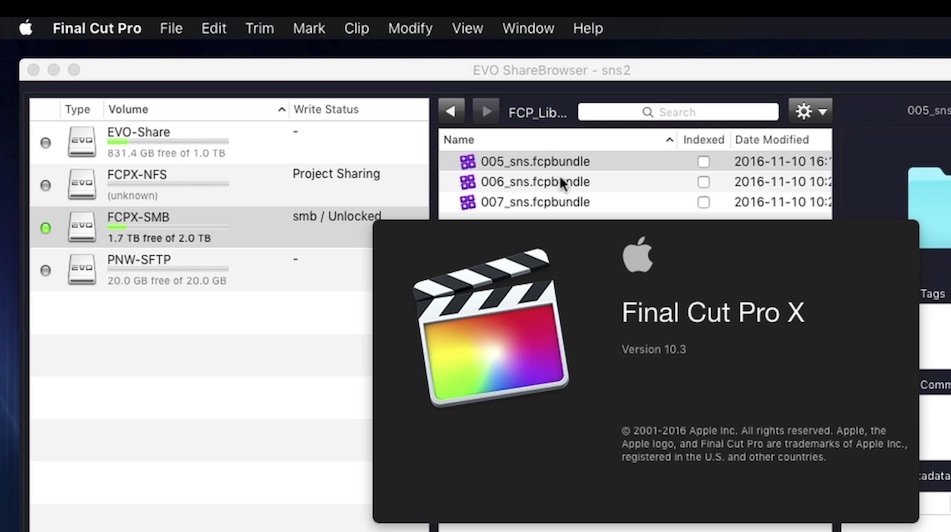Apple released Final Cut Pro X version 10.3 this month, and with it they introduced a nice bit of new functionality. Our favorite new feature in this release is definitely the announcement that Final Cut Pro now — finally! — allows its libraries to work on shared storage that uses the SMB file sharing network protocol.
In the release notes for this version Apple says “SMB 3 network support enables library access on network-attached storage devices.” This is great, because in previous versions of Final Cut Pro the library location options were effectively limited to Xsan or NFS. So yeah, now you can use FCPX libraries with SMB, which is really cool! In the past it was only possible to store your media for FCPX on SMB shares — not your libraries.
To be clear, this new feature does not mean that multiple editors can now work within the same FCPX library at the same time!
Rather, Apple now allows an FCPX library to be created on an SMB share, and exactly one user can have that library open on that SMB share at any given time. If a 2nd user attempts to open that same library, then FCPX will notify the 2nd user that permission is denied because the library is already opened “by Steve on Suite-C-iMac.” This is basically Final Cut Pro’s enforcement of write/read exclusivity for the user who first opens the library. Once that first user closes the library or quits FCPX then that library can be opened and edited by some other user.
FCPX using EVO Shared Storage
Our EVO shared storage servers have offered users several innovative and convenient FCPX library locking methods for years, by using the NFS protocol as well as other SAN-based solutions.
In combination with our included ShareBrowser management software, EVO allows multiple users to connect to an NFS share to store and access their FCP libraries. This workflow is enabled by using ShareBrowser Client, which “locks” an FCP library during network editing, so that a user can have a library open on an NFS share without the concern of it being accidentally overwritten by another editor. This method also allows ShareBrowser users a way to see if another user already has an FCP library locked without launching FCPX and trying to open the library.
Get the Official Final Cut Pro X Shared Storage Workflow Guide
With Apple’s introduction of SMB support for Final Cut libraries, [highlight color=”#c5d7f0″ rounded=”” class=”” id=””]FCP users with EVO now have another workflow option available.[/highlight] Our EVO shared storage system is capable of serving SMB shares as well as NFS shares, opening up this new SMB-based workflow to EVO users.
SMB or NFS?
One big advantage to using SMB instead of NFS is that SMB generally provides better write throughput performance — especially with 10GbE — when compared to NFS on a Mac OS. (SMB is natively supported in Windows operating systems. This may not seem like it would matter since we’re talking about FCP here which, of course, only runs on a Mac. But there are many cases when having to support just one protocol in a mixed Mac/Windows environment can make things much easier for everyone, and SMB is becoming pretty ubiquitous in the Mac world. For example: 5 FCPX workstations and a Windows-based After Effects, C4D, or Resolve workstation could all use a single network protocol, eliminating some complexity.) Additionally, mounting SMB shares is a much more common practice for users of both Mac and Windows platforms, meaning SMB is generally an easier protocol to support and work with on a daily basis.
With SMB support from Apple there’s now one more way to use your EVO with Final Cut Pro X.
Final Cut Pro X Libraries with EVO Shared Storage
Watch a 3m video of FCPX workflows — we demonstrate libraries on SMB and NFS, hosted on an EVO.
About EVO
EVO increases efficiency in your workflow by storing all of your media files and libraries in a centrally accessible storage system. By enabling real-time editing directly over the network EVO can eliminate the need for standalone RAIDs or individual drives for multiple workstations. Editors no longer have to move external drives around, nor do they need to worry about locating their media or managing duplicate files: With the proper setup they can just focus on editing.
Teams of editors can use EVO to handle multiple streams of ProRes-based media, 4K, and other codecs via standard 1GbE and/or 10GbE network connections, and in most cases editors can connect their workstations directly to EVO, with no additional switch requirements.
EVO is available in 16 bay, 8 bay, and 4 bay configurations, and includes unlimited licenses of ShareBrowser — an easy-to-use asset management app designed by SNS that ties all of your storage and project/media management into a single comprehensive window. The ShareBrowser desktop client enables your users to tag files and search across all EVO storage as well as local, offline, and other network disks. EVO servers can also generate proxy files for offline viewing via the ShareBrowser client.
Need help with setup?
If you’d like to use your EVO’s SMB shares for FCPX please contact our support team and mention this article — we’ll help get you setup (you’ll need to be running at least EVO OS v.5.8).
Want more info?
If you’d like to learn more about EVO please give us a call or complete this form and we’ll get in touch with you ASAP.

